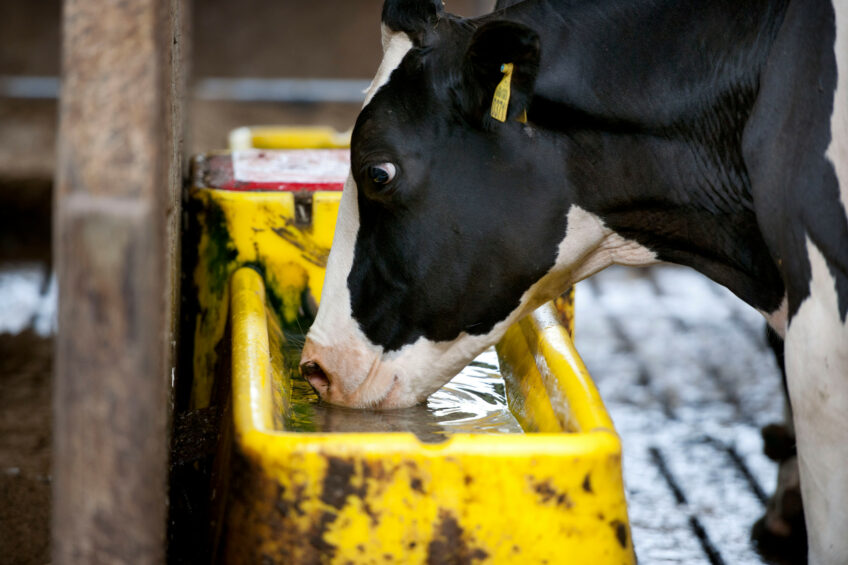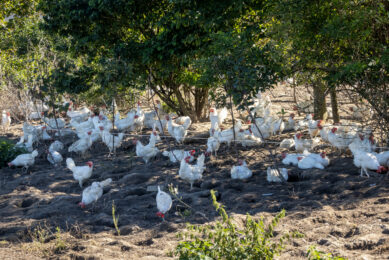Using nutrition to mitigate heat stress in ruminants

Feed and water consumption are important factors in managing heat stress in ruminants. This article provides insight into heat stress mitigation through nutritional interventions.
As Dr Remy Wyatt explains, heat stress occurs when an animal’s heat load exceeds its capacity to lose heat – and it’s worse not just with higher air temperatures, but with high humidity levels, sunlight versus shade and with little or no breeze. Wyatt is a consulting nutritionist at Great Plains Livestock Consulting in Nebraska, USA.
Gene editing
Among dairy cows, smaller breeds such as Jerseys and Guernseys fare better in heat than the popular Holstein. There is also active research looking into the ‘slick coat’ gene, which provides a smoother coat that absorbs less heat. Regarding coat colour, Holsteins have already been produced that have grey patches rather than black patches (with black absorbing more solar radiation). This gene edit can also be applied to Angus and other dark-coated beef cows.
But no matter the breed, coat type or coat colour, water and feed are important for heat stress mitigation. Here’s what’s new.
Watch minerals closely
Large volumes of water must be consumed by cattle during hot weather. However, Wyatt notes that not enough nutritionists and farmers are aware that with more water consumption comes greater excretion of some minerals (through increased urination).
“In general, trace minerals such as Zn, Cu, Mn will be excreted less through the urine than the macro minerals such as Ca, P, Na or K,” he explains. “Our electrolytes during these periods of heat stress are important, and Na and K work very closely in cell function. Cattle will retain more salt during these periods of heat stress when they excrete water and this imbalance of increased Na in the body should be balanced with K. I don’t believe many producers know you can do this. It’s just something that isn’t general knowledge.”

Time of feeding
Because digestion increases mammalian body temperature, feeding cows in the morning and evening during hot weather is a good idea. Wyatt notes that only some producers are aware of this, generally those who’ve worked with a nutritionist or have otherwise been exposed to this information.
“Feeding in the evening during the summer months gives cows an opportunity to spread the heat production from fermentation out during the coolest hours of the day and can be preferable, since cattle will more readily go to the bunk then and you reduce your risk of spoilage of feed sitting in the hot sun,” says Wyatt. “The biggest concern is to keep feed in front of the animal so that when they are hungry they can eat and thus use those nutrients for growth instead of leaving them in the bunk.”
And because cows generally eat less when it’s hot, reducing their feed delivery by 25% is a good idea to prevent spoilage of feed not eaten.
Transitioning cattle rations
Wyatt also explains that during heat stress events, it’s recommended to avoid switching transitioning cattle to a new ration – at the same time recognising that for backgrounding or feedlot cattle, there are periods of ration transition where diets increase in energy/starch to help add condition.
“We also add these transition diets to decrease the likelihood of acidosis and allow these cattle to acclimate to the higher starch diet,” he says. “Over time, cattle will generally go from low starch-high fibre rations to high starch-low fibre rations. Higher fibre in the diet will reduce the peak of heat fermentation, so transitioning to a higher starch diet during these periods should be avoided. It may cost them some performance, but not as much performance as a calf switching to a more concentrated ration and going off of feed from overeating during a heat event.”
Vasodilators
A relatively new area of heat stress mitigation through feed is vasodilators. These products increase the size of the blood vessels, allowing for more heat transfer out of the body. However, it’s important to note they also increase water intake.
Wyatt says there are quite a few products on the market containing the vasodilator capsaicin (the spicy component in hot peppers). He points to research in dairy cattle where feeding it has shown to increase milk yield, feed intake and overall performance.
However, giving it at a level that deters cows from eating is to be avoided.

“For beef cattle, I would say the biggest concern for me is the lack of peer-reviewed work in this area, which is understandable because research (especially cattle research) is expensive, time-consuming and less able to be controlled,” Wyatt says. “However, it needs to be done, because we have seen these areas where the climate is generally very mild have these random high heat, high-humidity situations that end terribly. Cattle that are used to 75-80°F (about 24-27°C) will not perform well in a heat index of 105°F (40.5°C), especially if they’re close to finishing weights. If there was a feed additive that could help offset the heat load in cattle experiencing these major heat events, increasing comfort and intake, performance in the long run would increase.”

Other feed additives
In June 2024, Dr Safdar Imran of the Islamia University of Bahawalpur in Pakistan and his colleague Dr Razia Kausar published a chapter called Heat Stress Mitigation through Feeding and Nutritional Interventions in Ruminants for an upcoming book tentatively entitled ‘Latest Scientific Findings in Ruminant Nutrition – Research for Practical Implementation.’
Imran and Kausar note a wide range of ingredients that can help mitigate ruminant heat stress, including minerals, vitamins, antioxidants (some of which are of course vitamins), fatty acids, yeasts, microbial products such as probiotics and plant extracts (see sidebar for details).
In terms of which of these, or which combination of them, holds the most promise to mitigate heat stress in cows, Imran does not point to any in particular. He says all of them “help lower metabolic heat production, that as a result, helps reduce heat stress by improving the balance of internal heat production and heat dissipation rates.”
Looking forward, Imran says heat stress mitigation through nutritional intervention needs more exploration at the molecular, cellular and organism levels. The first 2 levels involve looking at metabolic reaction stages, ion exchanges and energy levels/pathways involved in regulating absorption of nutrients, heat exchange and the corresponding effects.
At the organism level, he says, it’s about “observation of comfort level of animals after offering a particular feed stuff, feed composition and nutritional profile, intake, acceptance and expression of the animal’s response in different seasons or weather conditions.”











